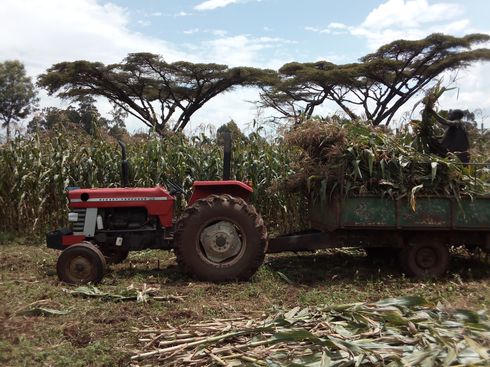Maize has been grown on our farm since way back. It is not only a staple in our diet but more recently it is fodder for the cows. Maize is the main ingredient that makes our staple food called ugali. It is eaten with just about anything. I have a feeling most people would say you give them ugali or give them death.

Harvesting maize for silage production
Maize farming is pretty straightforward. The first step is land preparation. This begins with ploughing, then harrowing to make the soil finer, then lastly planting. In more recent years, I prefer to make furrows so as to have straight evenly placed lines of crop. This is better as opposed to planting purely by hand.
Once the land preparation is done, usually just before the onset of the rains, the planting is then done. I usually have it done by hand as having it done mechanically is usually a bit more expensive. I also prefer to use farmyard manure as opposed to inorganic fertilizer when planting. The only exception is urea, which I used to top dress the maize crop.
Once planted, but before the maize plant germinates, I have found it useful to use a pre-emergent herbicide. It keeps the maize field clean until the maize crop is able to cover the ground and weeds trying to grow. The competition is thus reduced and the maize can do better.
I would ultimately prefer my maize farming to go the conservation agriculture way. This way the soil is disturbed less, weeds are not a problem due to the soil cover and the plants do better as opposed to purely rain-fed agriculture.
Once the maize is germinated, a spray program is the followed. This is to control insects and worms. In recent years there has been more infestation of cut worms especially. The other reason is to give the maize crop a boost with some foliar fertilizer. The foliar fertilizer I believe benefits the crop to be healthier.
Once the crop is about 2-3 feet tall, I usually top dress with urea. This is to help the crop grow well so that they are able to produce good ears of maize. I have found if the crop grows poorly in the earlier stages, the production is low and cannot be corrected later.
With everything managed in terms of growing, the only other aspect to be controlled in my case is crop damage from wild animals. The farm borders a forest. There is wildlife here that is a challenge. The most destructive being the monkeys. The other are porcupine. These two have to be controlled as both can lead to huge losses. I employ some people to guard the maize once the ears have cobs which are filling or filled with seed. Birds are also a problem to to a smaller degree.
When the maize crop is for making silage, the duration the maize has to be guarded is shorter. If it is for human consumption, the labor is required until the maize is dry enough to harvest. The wildlife problem is one of the reasons I prefer sorghum for fodder.
Once harvested and dried properly, the maize for human consumption is threshed and stored in airtight tanks. This makes sure there is very little post harvest loss. The olden ways of harvesting maize and putting into gunny bags, I have found to be problematic. Losses occur from weevil damage, rodents and rotting when maize comes into contact with moisture. The plastic airtight tanks control all the above problems.
The maize for silage is harvested at the dough stage. This is where the maize see has filled out but still has some moisture in the seed that when squeezed with the thumb produces some “milk”. The crop is then cut, chopped up, compressed to drive out all the air, then finally covered with an airtight plastic. It is the usually given about a month or two to ferment. After this period, the silage can then be fed to the cows.
Would I grow it again?
This is a staple food, I therefore grow it for Own consumption.
It is also a good fodder crop and is one of the highest in energy value to cows. Despite the challenges, I include it in list of crops that I grow.